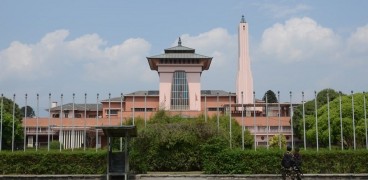The municipality is named after Lord Gautam Buddha's treasured relic, the old Ramgram Stupa.
Introduction To Ramgram Stupa
This historical, archaeological, and religious site in Nawalparasi is worth visiting. Although Lumbini, the birthplace of Lord Gautam Buddha, is a historical landmark, it is the only Ramgram Stupa to have attained enlightenment and become a Buddha and a tangible relic of the Buddha. It is a Koliya republic, with Panditpur in Nawalparasi as its capital.
Geologists have proven that the Koliyan Republic's capital is Panditpur in Nawalparasi, not Devadaha in Rupandehi. This location is currently located in the Ramgram Municipality of Ujaini. The Lord Gautam Buddha Ramgram Stupa in Ujaini, Ramgram Municipality, West Nawalparasi, is the world's only ossified metal Ramgram Stupa.
Religious and Cultural Importance of Ramgram Stupa
For several years, foreigners and Nepali Buddhists have gathered at this important religious, archaeological, and historical place to worship, light incense, perform musical instruments and sing hymns.
Myth Behind Ramgram Stupa
According to Buddhist scriptures, after a dispute over who would carry the relics after the Buddha's Mahaparinirvana (483 BC), the Buddha's bone metal was separated into eight portions. Magadha, Allakappa, Vaishali, Vaipdeep, Pava, Kapilvastu, Kushinagar, and Ramgram received Buddha's relics.
After diagnosing the same bone metal, the stupas were built in different locations. The bones, however, were scattered in various locations and were not preserved, according to the Mahavamsa (Sri Lankan genealogy).
Emperor Ashoka (3rd century BC) went to gather the bones of monk Mahakashyap during his expedition to erect 84,000 stupas. However, the snakes that lived under the protection of this location did not allow the removal of the bone metal, according to the same genealogy. This indicates that Ramgram was not part of the Mauryan Empire at the time. Similarly, Emperor Ashoka gathered the possessions of all the kingdoms but was unable to seize Ramgram due to the elephants' protection.
Beauty of Ramgram Stupa
Dandapani, the then-King Gautam Buddha's father-in-law, has built the stupa after the Buddha's death. Emperor Ashoka was reportedly intended to collect all of the fossils. According to accounts, Chinese adventurers Fayan and Huen Sang described the Ramgram in great detail in their travelogues.
Ramgram Stupa's Tourist Potential
Ramgram, like Lumbini, is expected to become a Buddhist pilgrimage site of international significance if it can be maintained and promoted.
A Chinese team has surveyed Ramgram Stupa, Nepal's historical and ancient sacred site, to construct a tourist attraction. The China-Nepal Cultural Exchange Center in Beijing, China, has expressed interest in developing the stupa by creating a tourist attraction surrounding the Ramgram Stupa to enhance the stupa's attractiveness. With its significant expenditure, the team has assessed the region around the Ramgram Stupa and indicated its ambition to establish a model pilgrimage destination.
How Can You Reach Ramgram Stupa?
The district headquarters at Parasi lies 3 kilometres south of the South Maheshpur road. The think of Ramgram Stupa can be seen on the plain on the bank of the Jharhi river after crossing and trekking 15 minutes east of Ujaini village.







